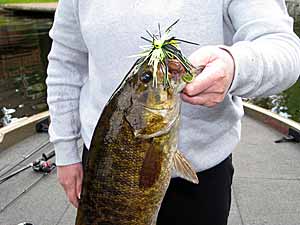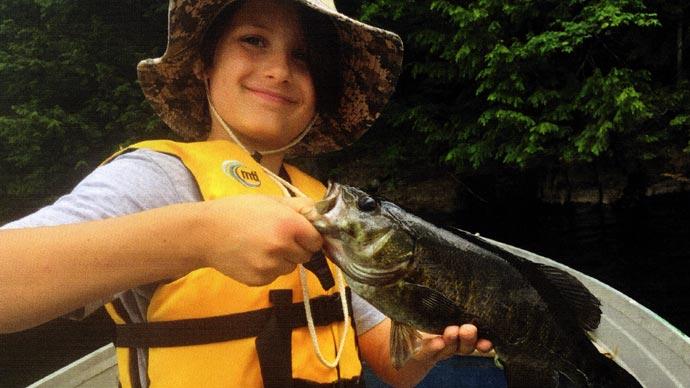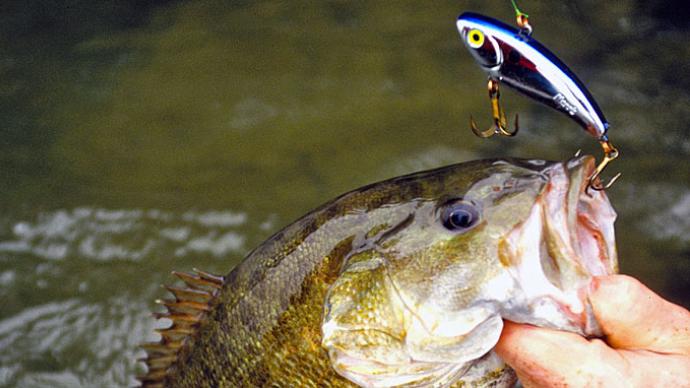
This is where the real fun begins, where we get to play with the magic of lures, where we get to go in search of that one lure that will knock them dead every time.
If you are like most of the fishermen I know, when you get to the place where you're going to start fishing, then you decide what lure you're going to use. I usually reverse that whole process. I frequently have the lure I will start fishing tied on before having the boat trailer hooked on the truck. My circumstances are very different from what you usually face. It will have only been a day or two since I last fished a particular place in most cases. I pretty much know ahead of time exactly where I will be fishing, how deep the water will be, and what the fish have been eating.
I have caught the first fish of each new season within four or five yards of the same place for the last four or five years. I have caught the last fish of the season in the same place as the first, for three or four of the last five or six years. I will catch the first fish of next season, in the same place and on the same lure I caught this season's first fish on. I use the combination of my experience and anticipated conditions on which to base my decision.
What do you base this decision on? Is it how deep or shallow the water is where you'll be fishing, or what the fish have been feeding on for the past couple of days, or what you think they will strike today? Just a hunch or gut feeling?
Several years ago, I paired with a tournament partner fishing his first tournament. I watched him fish all day with what I thought was the wrong lure. A lure he had picked because the previous year, on that same lake, on that lure, he had caught a four-pound bass. Of course, that was August, and this tournament was in April, less than a week after ice-out. But he was convinced that that was the magic lure.
I tried to "suggest" that he might want to re-think what he was doing. To the point where I caught six fish (the tournament limit was three), called him up by the live well, had him watch me release three, and told him they could have been his three. I offered him the lure I caught them on, and he still wouldn't take it. I mean, with some people, it's hard!
I have about a half dozen of what I call my high confidence lures. They will work almost any time, almost anywhere, from when the season starts until it ends if the fish are where I'm fishing. In actual practice, most days will start with the person in the bow using one of these, the person in the stern another, and me, in the middle, using a third. If two are topwater lures, the third will be on the bottom. If no one is catching fish, the reason is apparent. The dumb guide doesn't have you on fish! It's that simple. Now I know everyone wants to know what those six lures are, and I'll tell you later.
First, how did I pick them? They are not the result of one day of fishing, one season's worth of fishing, or even fishing on a single river or lake. They work on the Penobscot, Piscataquis, and Kennebec Rivers in Maine, as well as all of the lakes I have fished up here. Some of them, those that I have tried, worked on Lake Powell in Arizona, and they all have worked on every other place wherever I have ever tried them.
They have worked on Smallmouth Bass, Largemouth Bass, Striped Bass, Pickerel, Atlantic Salmon, Landlocked Salmon, several kinds of Trout, a variety of Sunfish, River Chubs, and a White Sucker or two, Mackerel and Bluefish. These fish, from Maine to Arizona on the same six lures. Then someone asks, "What's your favorite lure?" All of them!
Now think about this for a minute. I'm not just talking about confidence. I'm talking about complete confidence. If the fish are there, these six lures will catch them. No ifs, and, or buts about it. Put these six lures in front of the fish, and you will get bit. If you aren't getting bit, move, you haven't found the fish yet.
About now, many of you think that I'm full of beans and buttermilk (or something). Feel free to think about that. It's your choice, and I have no problem with it. This is what I do guiding. It's how I fish, and there has been one day when I have had clients skunked in the last eleven years. And I know why, and it wasn't the lures. We had found the fish, could see the fish, lots of fish, but they had other things on their minds that day. The very next day, in the very same places, we caught and released over thirty that weighed three pounds or better.
By now, some of you are reading ahead looking for me to name them, so here they are. The first is Pradco's Floating 4" Rebel. Some of you call this a jerkbait. I don't call them jerkbaits. I refuse to accept that there is such a thing as a jerkbait, and I certainly don't use them. To me, this is a surface "twitch" bait; a teaser type of lure to be activated with a minimum of motion either on or just under the surface. It is effective about ten to twenty percent of the time, but it is very effective when working.
My second choice is not in any order of preference because the time of year influences that, but in any case, my second lure is a Mepps Aglia in-line spinner. I use these in sizes from #3 on up to the Musky Killers. The size of the smallmouth you can occasionally catch on the little #3s will sometimes scare you. We use these from just under the surface to just above the bottom, and I have even caught catfish on these. I usually select these in the boat if I get into trouble, and they have never failed me over the years. If the smaller fish get too "pesky," I move up to a larger size. I suspect the larger spinners intimidate the small fish a bit. I prefer the squirrel tail dressing, but I don't believe it makes much difference to the fish.
Now for the Gary Yamamoto lures. They are my other four choices. And the Gary Yamamoto grubs, probably the lure they are best known for, don't even make my list. I used the Yamamoto lures for 90% or more of my fishing last season and never needed anything else.
The first two I will name are pretty much interchangeable. The big difference in my mind is that I think of one, The 6" Senko, as being a "surface" lure or one to be used close to the surface and the Big Ika, (Pronounced Reka. I said it wrong for almost a year before I learned better) which I view as a bottom lure or one to be used close to the bottom. Having said this, I have to tell you I have caught fish near the bottom, on the top, and in between.
Please don't waste time trying to understand my mind, I still don't, and I have lived with it for 64 years. Gary Yamamoto makes four Senkos and two sizes of Ika, but I have named the ones I use the most. I further suspect that I could get away with using only these two lures for the entire season and not have it cost me any fish. Anyhow these are numbers three and four.
Number five is also a Gary Yamamoto lure, the 99 series (more extensive) skirted double tail grub. Not an authentic grub, but rather a great big spider jig -- a truly strange and versatile lure. When un-weighted, it has a prolonged rate of fall, which has helped us catch a bunch of fish. They can be rigged on a jig head, fished with a worm hook, or almost "floated" on Yamamoto's Split Shot Hook, which happens to be "lure" number six, and which we frequently use with the Ika and Senko Lures as well.
Of course, as the name implies, the split shot hooks can be used either by themselves or with a split shot. All these Yamamoto lures can be rigged lip-hooked with the split shot hook or with an offset worm hook, with or without a slip sinker or with a jig head. There are probably several other ways to rig them that I haven't even thought about, but the fish have kept us busy enough with the mentioned rigs that I have neither the time nor desire to experiment further. We have fished these hooked frontwards, backward, backward with the "legs" bit off, with weight, without weight, on jig heads, plain hooks, and circle hooks and have caught fish every way we try them. We have even caught fish, lots of fish on the Senko, rigged with a circle hook right in the middle a-la wacky worm. If I keep on with this, I will have to start selling snake oil.
You develop a straightforward, basic strategy when putting this whole package together. If you are not catching fish, move. For me, on the rivers where I fish, this is precisely how we approach the problem of catching fish. Frequently my newer clients want to use "other" lures. No problem. They get to use what they want. I'll tie on something, Yamamoto, and fish out of the center of the boat, saving the prime cover for the clients. More often than not, they are asking me for a Yamamoto lure that they can use within the first hour. I "happen" to know a guy who has some.
Several years ago, I quit using grubs because I caught too many small fish. My average size increased by nearly a quarter-pound when I switched to tubes. I had no desire to change back to grubs for that reason. The numbers improved with the switch to Yamamoto's larger lures, and the size remained about the same. With the switch to the split shot hooks instead of the jig heads, the numbers and size have remained about the same. But the incident of deep-hooking has decreased dramatically, and the fishing has gotten a lot easier. I guess I am just lazy, but that works for me. Somewhere down the road, if the interest is here, we'll get into the specifics of rigging and fishing these lures.
OK. So what's the point of all of this series to you, the folks that have done me the courtesy of taking the time to read this. The point to me is this: All of the excuses are gone. The blame, in my case, is right where it belongs, on me, whether we are catching fish or not catching fish. If we are catching, it's because I did my job and found them. If not, I did not. It is that easy for me, and it can be that easy for you.
I am very, very lucky to spend so much time where there are a bunch of smallmouths. Most of you do not have that opportunity. Doesn't it make sense to simplify your system and make it work as well for you, as mine works for me?
Rules. Smallmouth fishermen hate rules.
Rule #1 Fish where the fish are.
Rule #2 Fish these baits.
Rule #3 If you aren't catching fish, see rule #1.
It works for me, and it will work for you as well.



